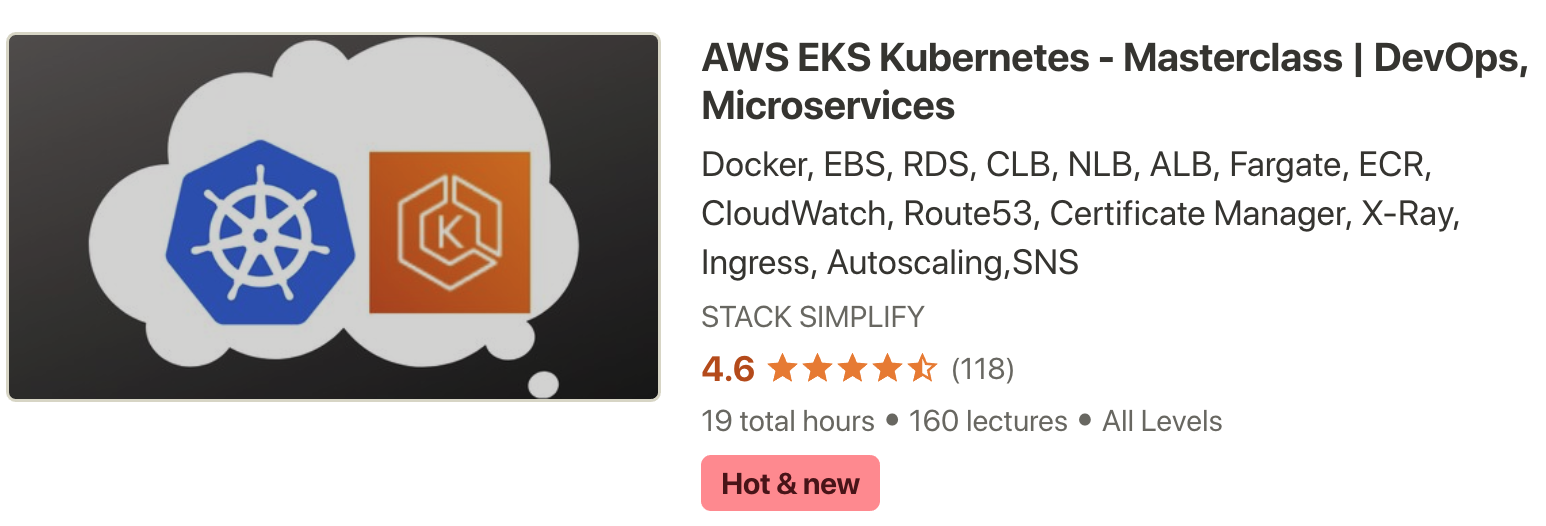Use RDS Database for Workloads running on AWS EKS Cluster
Step-01: Introduction
- What are the problems with MySQL Pod & EBS CSI?
- How we are going to solve them using AWS RDS Database?
Kubernetes Manifests
Step-02: Create RDS Database
Review VPC of our EKS Cluster
- Go to Services -> VPC
- VPC Name: eksctl-eksdemo1-cluster/VPC
Pre-requisite-1: Create DB Security Group
- Create security group to allow access for RDS Database on port 3306
- Security group name: eks_rds_db_sg
- Description: Allow access for RDS Database on Port 3306
- VPC: eksctl-eksdemo1-cluster/VPC
- Inbound Rules
- Type: MySQL/Aurora
- Protocol: TPC
- Port: 3306
- Source: Anywhere (0.0.0.0/0)
- Description: Allow access for RDS Database on Port 3306
- Outbound Rules
- Leave to defaults
Pre-requisite-2: Create DB Subnet Group in RDS
- Go to RDS -> Subnet Groups
- Click on Create DB Subnet Group
- Name: eks-rds-db-subnetgroup
- Description: EKS RDS DB Subnet Group
- VPC: eksctl-eksdemo1-cluster/VPC
- Availability Zones: us-east-1a, us-east-1b
- Subnets: 2 subnets in 2 AZs
- Click on Create
Create RDS Database
- Go to Services -> RDS
- Click on Create Database
- Choose a Database Creation Method: Standard Create
- Engine Options: MySQL
- Edition: MySQL Community
- Version: 5.7.22 (default populated)
- Template Size: Free Tier
- DB instance identifier: usermgmtdb
- Master Username: dbadmin
- Master Password: dbpassword11
- Confirm Password: dbpassword11
- DB Instance Size: leave to defaults
- Storage: leave to defaults
- Connectivity
- VPC: eksctl-eksdemo1-cluster/VPC
- Additional Connectivity Configuration
- Subnet Group: eks-rds-db-subnetgroup
- Publicyly accessible: YES (for our learning and troubleshooting - if required)
- VPC Security Group: Create New
- Name: eks-rds-db-securitygroup
- Availability Zone: No Preference
- Database Port: 3306
- Rest all leave to defaults
- Click on Create Database
Edit Database Security to Allow Access from 0.0.0.0/0
- Go to EC2 -> Security Groups -> eks-rds-db-securitygroup
- Edit Inboud Rules
- Source: Anywhere (0.0.0.0/0) (Allow access from everywhere for now)
AWS EKS - Elastic Kubernetes Service - Masterclass

Step-03: Create Kubernetes externalName service Manifest and Deploy
- Create mysql externalName Service
- 01-MySQL-externalName-Service.yml
apiVersion: v1
kind: Service
metadata:
name: mysql
spec:
type: ExternalName
externalName: usermgmtdb.c7hldelt9xfp.us-east-1.rds.amazonaws.com
- Deploy Manifest
kubectl apply -f kube-manifests/01-MySQL-externalName-Service.yml
Step-04: Connect to RDS Database using kubectl and create usermgmt schema/db
kubectl run -it --rm --image=mysql:5.7.22 --restart=Never mysql-client -- mysql -h usermgmtdb.c7hldelt9xfp.us-east-1.rds.amazonaws.com -u dbadmin -pdbpassword11
mysql> show schemas;
mysql> create database usermgmt;
mysql> show schemas;
mysql> exit
Step-05: In User Management Microservice deployment file change username from root to dbadmin
- 02-UserManagementMicroservice-Deployment-Service.yml
# Change From
- name: DB_USERNAME
value: "root"
# Change To
- name: DB_USERNAME
value: "dbadmin"
Step-06: Deploy User Management Microservice and Test
# Deploy all Manifests
kubectl apply -f kube-manifests/
# List Pods
kubectl get pods
# Stream pod logs to verify DB Connection is successful from SpringBoot Application
kubectl logs -f <pod-name>
Step-07: Access Application
# Capture Worker Node External IP or Public IP
kubectl get nodes -o wide
# Access Application
http://<Worker-Node-Public-Ip>:31231/usermgmt/health-status
Step-08: Clean Up
# Delete all Objects created
kubectl delete -f kube-manifests/
# Verify current Kubernetes Objects
kubectl get all
